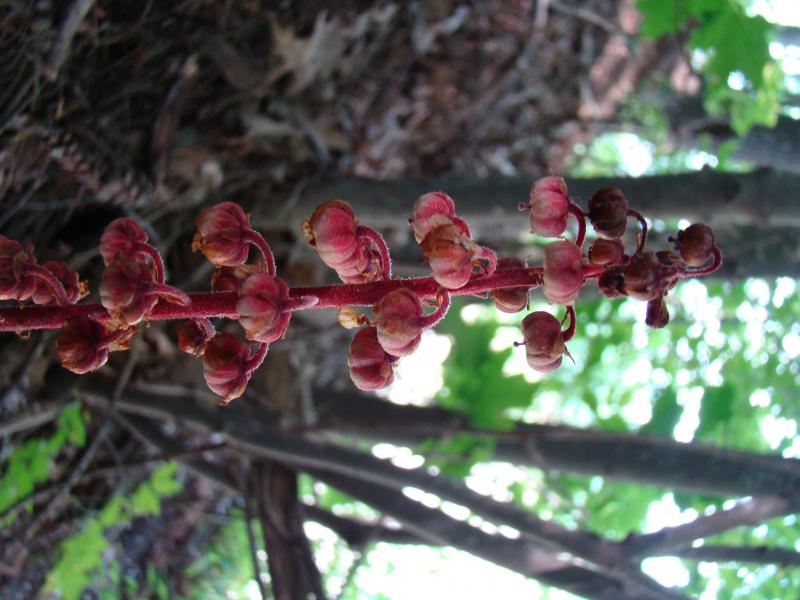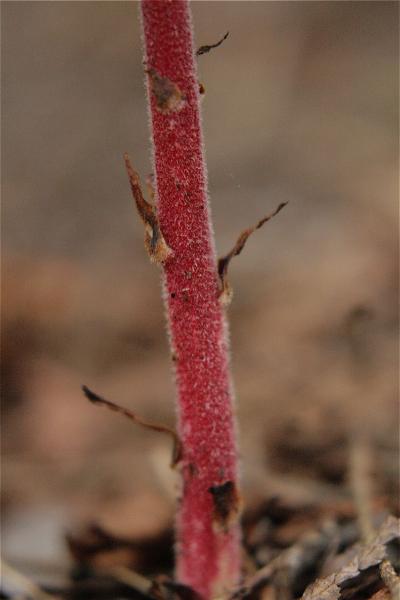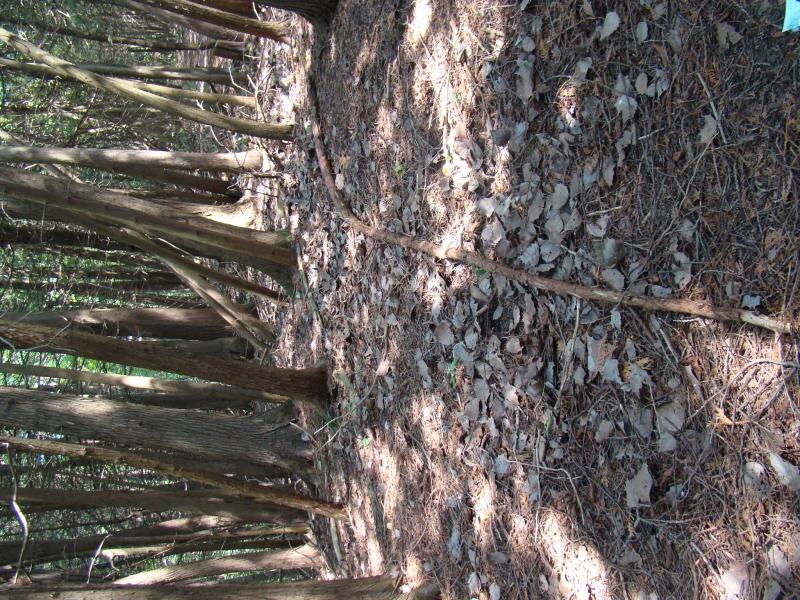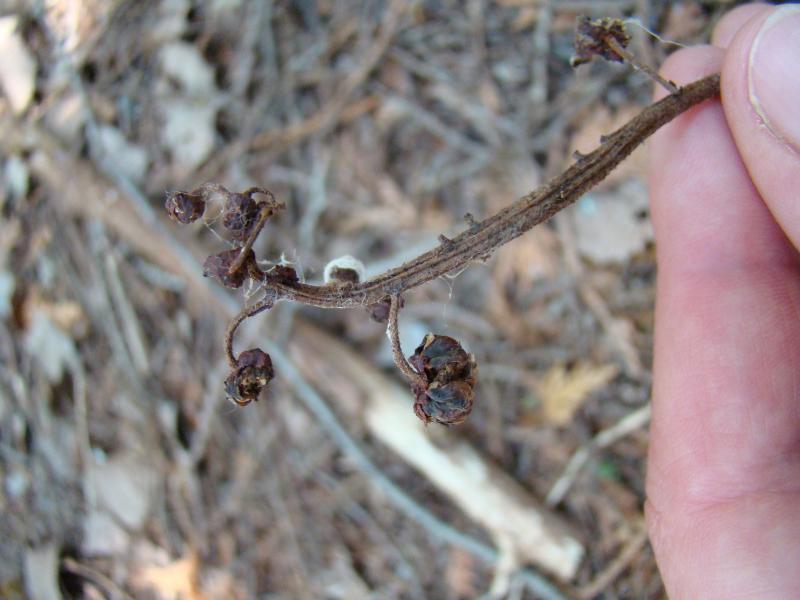Pine Drops
Pterospora andromedea Nutt.
- Class
- Dicotyledoneae (Dicots)
- Family
- Ericaceae (Heath Family)
- State Protection
- Endangered
Listed as Endangered by New York State: in imminent danger of extirpation in New York. For animals, taking, importation, transportation, or possession is prohibited, except under license or permit. For plants, removal or damage without the consent of the landowner is prohibited.
- Federal Protection
- Not Listed
- State Conservation Status Rank
- S1
Critically Imperiled in New York - Especially vulnerable to disappearing from New York due to extreme rarity or other factors; typically 5 or fewer populations or locations in New York, very few individuals, very restricted range, very few remaining acres (or miles of stream), and/or very steep declines.
- Global Conservation Status Rank
- G5
Secure globally - Common in the world; widespread and abundant (but may be rare in some parts of its range).
Summary
Did you know?
Giant pinedrops also has the common name Albany pinedrops because some of the earliest collections were from the Albany, NY area. It was first collected in Albany in 1817 by Edwin James, a Vermont botanist who came to Albany in 1816 after graduating from Middlebury College. He studied botany with state botanist John Torrey but eventually spent most of his career in the western US (Wikipedia contributors). He completed the first recorded ascent of Pikes Peak in Colorado in 1820 and on the trip was the first to describe the blue columbine, Colorado's state flower (Wikipedia contributors).
State Ranking Justification
There are five existing populations with no more than 25 plants each. There are 30 historical occurrences mostly from the 1800s and early 1900s. One population from the 1970s and one from the 1990s have not been found again.
Short-term Trends
Populations seem to be holding steady at low numbers.
Long-term Trends
This species was known from many sites across the state but saw a large decline in the last half of the 20th century. Only a handful of sites are known today.
Conservation and Management
Threats
One population is subject to flooding during severe flood events. Two populations are close to trails and could easily be trampled or picked. This species may respond to disturbance and may be declining due to succession.
Conservation Strategies and Management Practices
Reroute trails away from plants.
Research Needs
Research is ongoing into the relationship of this plant with soil mycorrhizae in order to explain the sharp decline in populations east of the Mississippi. More research could be done to determine habitat requirements.
Habitat
Habitat
In New York (as in the rest of its range) Pterospora andromedea is known from a wide diversity of forested habitats. Lacking chlorophyll, it it derives nutrients through mycorrhizal (fungal) connections with tree roots - most notably pines and other conifers, though it may also parasitize beech (Fagus grandifolia) or other hardwoods. In New York it has been found in river gorges, steep south-facing slopes, mature forests, and second-growth forests, most often where white pine is a component of the overstory (New York Natural Heritage Program 2010). Evergreen to mixed evergreen-deciduous forests (Haines 2011). Moist to dry, often deep humus of mixed-deciduous or coniferous forests (sometimes on calcareous substrates) (FNA 2008). Nearly alwasy in habitats with conifers (especially pines but also hemlock, spruce, fir, white=cedar, in dryish (or rocky) soil, often with common juniper and sometimes aspen or birch (Voss 1996). Coniferous woods, chiefly in dry soil (Gleason & Cronquist 1991).
Associated Ecological Communities
- Appalachian oak-pine forest
(guide)
A mixed forest that occurs on sandy soils, sandy ravines in pine barrens, or on slopes with rocky soils that are well-drained. The canopy is dominated by a mixture of oaks and pines.
- Beech-maple mesic forest
(guide)
A hardwood forest with sugar maple and American beech codominant. This is a broadly defined community type with several variants. These forests occur on moist, well-drained, usually acid soils. Common associates are yellow birch, white ash, hop hornbeam, and red maple.
- Hemlock-northern hardwood forest
(guide)
A mixed forest that typically occurs on middle to lower slopes of ravines, on cool, mid-elevation slopes, and on moist, well-drained sites at the margins of swamps. Eastern hemlock is present and is often the most abundant tree in the forest.
- Limestone woodland
(guide)
A woodland that occurs on shallow soils over limestone bedrock in non-alvar settings, and usually includes numerous rock outcrops. There are usually several codominant trees, although one species may become dominant in any one stand.
Associated Species
- Abies balsamea (balsam fir)
- Acer rubrum
- Betula papyrifera (paper birch)
- Carex pensylvanica (Pennsylvania sedge)
- Cornus florida (flowering dogwood)
- Gaylussacia baccata (black huckleberry)
- Hamamelis virginiana (witch-hazel)
- Juniperus virginiana
- Lathyrus ochroleucus (pale vetchling)
- Lilium philadelphicum (wood lily)
- Phlox subulata
- Picea glauca (white spruce)
- Pinus resinosa (red pine)
- Pinus strobus (white pine)
- Quercus
- Thuja occidentalis (northern white cedar, arbor vitae)
- Tsuga canadensis (eastern hemlock)
- Vaccinium pallidum (hillside blueberry)
- Viburnum acerifolium (maple-leaved viburnum)
Range
New York State Distribution
There are records of Giant Pine-drops scattered across most of New York north of the lower Hudson Valley.
Global Distribution
Giant Pine-drops is found in Alaska, most of Canada and the western U.S. states, and east along the northern tier of states from Michigan to New Hampshire.
Identification Comments
General Description
Ptersopora andromedea is a native, herbaceous, saprophytic perennial that grows from a truffle fungus, which in turn is most often associated with Pinus strobus. It has one to several simple, erect, herbaceous glandular-hairy stems, reaching 30 cm to 1 m tall. Lacking chlorophyll, its stems are pink to reddish or maroon (and eventually brownish) in color and bear numerous scale-like leaves. The numerous flowers are stalked, nodding and borne in an elongated unbranched terminal inflorescence (raceme). The flowers are bell-shaped with white petals 6 to 9 mm long and reddish to maroon sepals 2 to 3 mm long, which form a cap-like whorl encompassing the flower bases. The fruits are persistent, thin-segmented capsules 5 to 10 mm wide by 7 to 14 mm long, which split at maturity, revealing tiny (0.2 to 0.5 mm) seeds with membranous wings. Pine-drops is parasitic upon the roots of members of the Pinaceae, specifically Pinus strobus in New York. American beech and other hardwoods have been reported as hosts elsewhere. (Higman and Penskar 1999)
Identifying Characteristics
Ptersopora andromedea is a native, harbaceous, saprophytic perennial that grows from a fungus, which in turn is associated with Pinus strobus. It has one to several simple, erect, herbaceous glandular-hairy stems, reaching 30 cm to 1 m tall. The stems are pink to reddish or maroon (and eventually brownish) colored and bear numerous scale-like leaves. The numerous flowers are stalked, nodding and borne in an elongated unbranched terminal inflorescence (raceme) with a stout, 0.5 to 1.5 cm axis. The flowers are bell-shaped (campanulate) have white petals (corolla) 6 to 9 mm long and reddish to maroon sepals (2 to 3 mm long) forming a cap like whorl encompassing their base. The fruits are persistent, thin-segmented capsules 5 to 10 mm by 7 to 14 mm which split at maturity (dehiscent), enclosing tiny (0.2 to 0.5 mm) seeds with membranous wings. Pine-drops is parasitic upon the roots of members of the Pinaceae, specifically Pinus strobus in New York. (American beech or other hardwoods have been reported as hosts elsewhere). (Higman and Penskar 1999)
Best Life Stage for Proper Identification
Fresh fruiting or flowering stems are best for positive identification. Mature intact, sterile stems may also be identified.
Similar Species
There are superficially similar saprophyte species (Monotropa uniflora, M .hypopithys, and Epifagus virginiana) occuring in New York but with even cursory examination they are notably distinctive. Monotropa species are typically half the size of Pterospora or smaller and have only one flower per stem that becomes erect in fruit. Epifagus plants are often much branched when they are large and the stems are cream, tan or purple-striped and mostly smooth and hairless. Their flowers are tubular and the species is only parasitic on American beech. In contrast, Pterospora is large, glandular-hairy with numerous flowers in a elongated terminal inflorescence (raceme), and is associated most commonly with pines or other conifer species.
Best Time to See
Pterospora plants may go many years without sending up flowering/fruiting stalks. Plants appear infrequently, only emerging when environmental conditions are ideal. It flowers in late June through August, with a typically optimal period from July through mid- to late August when the flowers and fruits are in their prime. The tough, dry fruiting stems can be may be found well into winter and may persist for a year or more if not knocked over or removed. (Higman and Penskar 1999).
- Flowering
- Fruiting
The time of year you would expect to find Pine Drops flowering and fruiting in New York.
Pine Drops Images
Taxonomy
Pine Drops
Pterospora andromedea Nutt.
- Kingdom Plantae
- Phylum Anthophyta
- Class Dicotyledoneae
(Dicots)
- Order Ericales
- Family Ericaceae (Heath Family)
- Order Ericales
- Class Dicotyledoneae
(Dicots)
- Phylum Anthophyta
Additional Common Names
- Albany Beech Drops
- Giant Bird's-nest
- Pinedrops
Synonyms
- Monotropa procera Torrey ex Eaton
- Pterospora andromeda auct. non
Additional Resources
Best Identification Reference
Flora of North America Editorial Committee. 2010. Flora of North America North of Mexico. Vol. 08. Magnoliophyta: Paeoniaceae to Ericaceae. Oxford Univ. Press, New York. xxiv + 585 pp.
Other References
Fernald, M.L. 1950. Gray's manual of botany. 8th edition. D. Van Nostrand, New York. 1632 pp.
Gleason, Henry A. and A. Cronquist. 1991. Manual of Vascular Plants of Northeastern United States and Adjacent Canada. The New York Botanical Garden, Bronx, New York. 910 pp.
Haines, A. 2011. Flora Novae Angliae: a manual for the identification of native and naturalized higher vascular plants of New England. Yale University Press, New Haven, CT. 973 pp.
Holmgren, Noel. 1998. The Illustrated Companion to Gleason and Cronquist's Manual. Illustrations of the Vascular Plants of Northeastern United States and Adjacent Canada. The New York Botanical Garden, Bronx, New York.
Mitchell, Richard S. and Gordon C. Tucker. 1997. Revised Checklist of New York State Plants. Contributions to a Flora of New York State. Checklist IV. Bulletin No. 490. New York State Museum. Albany, NY. 400 pp.
New York Natural Heritage Program. 2024. New York Natural Heritage Program Databases. Albany, NY.
Reschke, Carol. 1990. Ecological communities of New York State. New York Natural Heritage Program, New York State Department of Environmental Conservation. Latham, NY. 96 pp. plus xi.
Voss, E.G. 1996. Michigan Flora. Part III. Dicots (Pyrolaceae-Compositae). Cranbrook Institute of Science Bulletin 61 and Univ. Michigan Herbarium. Ann Arbor, Michigan. 622 pp.
Weldy, T. and D. Werier. 2010. New York flora atlas. [S.M. Landry, K.N. Campbell, and L.D. Mabe (original application development), Florida Center for Community Design and Research http://www.fccdr.usf.edu/. University of South Florida http://www.usf.edu/]. New York Flora Association http://newyork.plantatlas.usf.edu/, Albany, New York
Links
About This Guide
This guide was authored by: Stephen M. Young, Elizabeth Spencer, Richard M. Ring.
Information for this guide was last updated on: April 2, 2013
Please cite this page as:
New York Natural Heritage Program. 2024.
Online Conservation Guide for
Pterospora andromedea.
Available from: https://guides.nynhp.org/pinedrops/.
Accessed July 26, 2024.




